
Written by Jared T. Hooper on 07 Feb 2025
Distributor DANGEN Entertainment • Price £16.75
Indie developer Bombservice's flagship series is Momodora, but in between the release of Reverie Under the Moonlight and Moonlit Farewell, they released a completely standalone metroidvania, Minoria, with next to no connections to Momodora, besides some cameo weapons, making it the black sheep in their catalog. Despite this peculiarity, Minoria stands strongly on its own with a fast-paced, fluid combat system, and builds off the grim atmosphere that makes Reverie Under the Moonlight an indie darling.
Atmosphere & Story
Momodora IV is quite the dreary title, a complete 180 from earlier entries, which were brighter in color or tone, and Minoria takes the despair of IV, grinds it into hopelessness, and also manages to germinate melancholy from the bonemeal, and these flowers greet the player the very moment they reach the title screen.
Minoria's title screen is a contrast to Momodora IV's title screen, which features the protagonist looking out at a towering castle from a cliff as the wind plays with her cowl. Minoria's title screen is the game's logo, text set against an illustration of a flower whose blue palette gives the appearance of a crystal, flocked by butterflies whose silhouettes are visible only for their faint glows. Flanking the logo are scratchboard outlines of the game's two main characters, Sister Semilla and Fran, the former standing with a pensive, troubled expression, the latter clasping her hands together for a prayer heard between only her and her deity. The young women fade in, fade out, fade in, and fade out again as the sobering notes of a piano reverberate, accompanied halfway through the piece by the drawing of bows on violin strings. All in all, a simple title screen, right on the edge of minimalism, and it's this simplicity that draws out the beauty of the art and the song titled Reminiscence as the player listens to the notes' echoes, studies the fading faces of the young women, wonders what tragedies lie ahead.
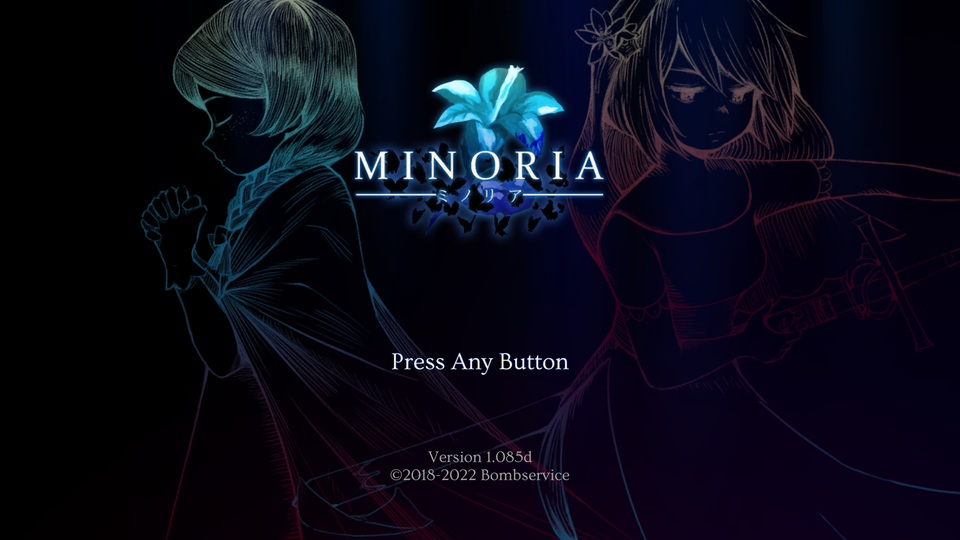
The tone settles into despondency with the very first shot as Fran examining corpses that have been run through twice each and set ablaze, as though their murderers were extraordinarily fearful, to where they sought to block the possibility of reanimation after death. That or a hatred that runs so deep, they had no floor to stop. And it's this grisly tone that remains prominent. Momodora IV is a dark game, but much of its atmosphere is a lingering unease at not knowing if or how the situation will worsen. Minoria, by contrast, is the aftermath of a massacre, with corpses littering every other corridor and fires burning where flammable material exists. One particularly striking chamber presents a woman's corpse nailed to a column with a pair of blades, blood steadily dripping from her wounds. This makes the difference in accomplishment between the two titles far divergent, with the former feeling like a rush to sandbag the break in a levee, while the latter is rowing down already-flooded streets.
To contextualize this grimmer atmosphere, the story of Minoria has the battle nun Sister Semilla and her partner and friend Fran embark on a mission to quell an insurrection by witches per orders of the church they serve. Frankly, it's Momodora IV's story with a new coat of paint, but Minoria fleshes out its world and plot with more engaged dialogues and lore, and the lore here is quite fascinating. The short of it is that the church is a self-interested organization that brooks no criticism, protest, or revolt and will resort to heinous tactics to maintain its grip on power. A common tactic is persecuting those it accuses of witchcraft and conscripting their kin into service in order to “atone for sins,” and the definition of witch is my favorite piece of lore, because it doesn't denote someone who practices magic* but is instead the church's custom term for opposition. If the church doesn't like you, you're labeled as a witch and appropriately dealt with.
That glaring asterisk hanging there is to signal that the lore, great as it is, also contradicts itself with another entry that states witches are, in fact, people who do practice magic, even undergoing a sort of metamorphosis for that end, leaving me to ask, which is it? Are witches made literally, or is it just a title? I think the official stance is that witches are basically a separate fantasy race capable of magic, and the church isn't too big on witchcraft, so they mark all witches as heretics. Some editing could clear up the confusion the lore text instills, such as giving magic-users a different title, like sorceress or enchantress or something, to individualize them from the church-coined term witch.
When it comes to the story itself, that needs a lot more editing, because almost right away, we run into problems. Semilla's first major task is hunting down a witch and squeezing her for information. She accomplishes the first half of that, fighting her in a tough boss battle, but then she kills her, and then Fran goes, “D'oh well. Time to move on!” Meanwhile, I was sitting there like, “Hold the gramophone. Weren't we supposed to waterboard her for intel? Why are we acting like we totally didn't botch our objective?” This is the biggest quandary with the story, which is that while it technically tells a complete tale, the manuscript feels like it's missing pages.
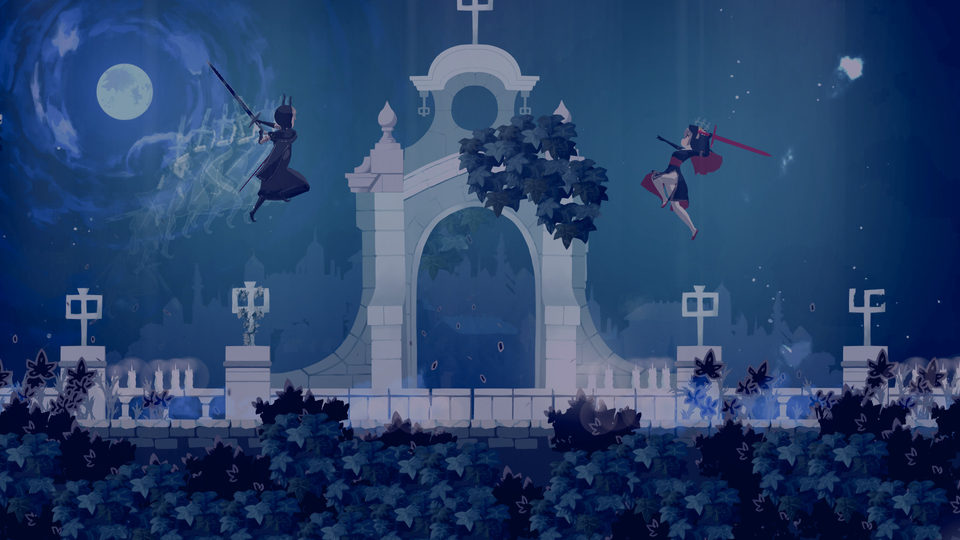
Starting from this first hitch, all we need is a brief exchange where Semilla begins interrogating the witch, who then bites down on a cyanide capsule in order to take her secrets to the grave. Fran going, “D'oh well. Time to move on!” makes sense with this small addition, whereas with what the game has, where the only route to continue the story is to slay the boss, it makes the characters come off as extraordinarily incompetent at their jobs.
Another moment of incompetence happens later on when a princess you lock in a library for safekeeping vanishes halfway through the game and all the librarian charged with watching her has to say is, “D'oh well. Something must've happened when I wasn't looking,” to which I responded, “How?! This library's barely bigger than a studio apartment.” I thought this was teasing a twist in allegiances of the librarian, but nothing of the sort ever happens. The princess goes poof and we're just supposed to roll with it.
The next major story beat is when Semilla and Fran are drugged and locked up in an underground prison and make an escape, and while this portion is largely a complete arc, it's also the last bit of story until the ending, which I will be spoiling to discuss, so be warned.
After beating the final boss, you're given one of two choices: do you side with the witches, whose forces you've been fighting all this time, or do you remain allied with the church? About as standard as an end-game binary is, but the kicker is that unless you read the numerous records that describe the authoritarian rule of the church and how the witches are people who just want to live their lives, there's no real cause or incentive for the player electing to side with the witches. The records shouldn't be mandatory reading, but the main story does need something for the player to latch on to so that when they do reach that critical decision, siding with the witches doesn't come off as absurd. But the kicker is that the game already employs that something.
When you get the healthbars of the second and third bosses down to about a quarter, they enter a weakened state which renders them next to harmless. I just stood and watched as a headstrong warrior who not a moment earlier had been giving me a run for my money could barely muster the strength to walk, let alone swing a sword. The one thing on her that hadn't broken was her conviction.
Disquieting as it was witnessing these powerful beings teeter on the precipice of death, you might have noticed how I stated this happens for only two early-game bosses, and spoiler alert, this game has more than two bosses. Every other boss stays strong until their health drops to zero, and I don't see why the other bosses couldn't have received this same treatment.
Bosses reckoning with their mortality wouldn't necessarily convince the player they might not be the bad guys, but it, coupled with some final frustrated or saddened words about the lives they never got to lead, can plant the seed in the player's mind that there's more to this conflict than an apparent good guys vs. bad guys scenario. Likewise, the story needs to have moments where the evils of the church are more manifest so that we think twice about remaining allied with them in the end.
There is one thing the ending does really well, and it's that it forces you to commit. There's no reloading a previous save to check out the other ending. If you play on PC, you can fiddle with the save files so you can “reload” an old save, but otherwise, once you make a choice, you're locked in. This works particularly well for the one ending in which Fran wonders if you made the right choice, which can be haunting when the game forbids you from easily switching to that other choice. I do, however, think this theme of “living with your decision” would be more effective if the player had additional choices throughout they had to live with. For example, the player can meet a talking slug who claims to have been a girl named Almu, and they have the choice of believing her or not. I don't know what happens if you choose not to believe it, because I can't find any information online, and in all the playthroughs I checked, the uploader opts to believe the slug, but let's pretend for a moment that by not believing the slug, it attacks you. You put it down because it's now a hostile, and then later on, you come across a character who says, “I got separated by my friend Almu. Have you seen her?” and the player will either rejoice or regret their earlier decision.
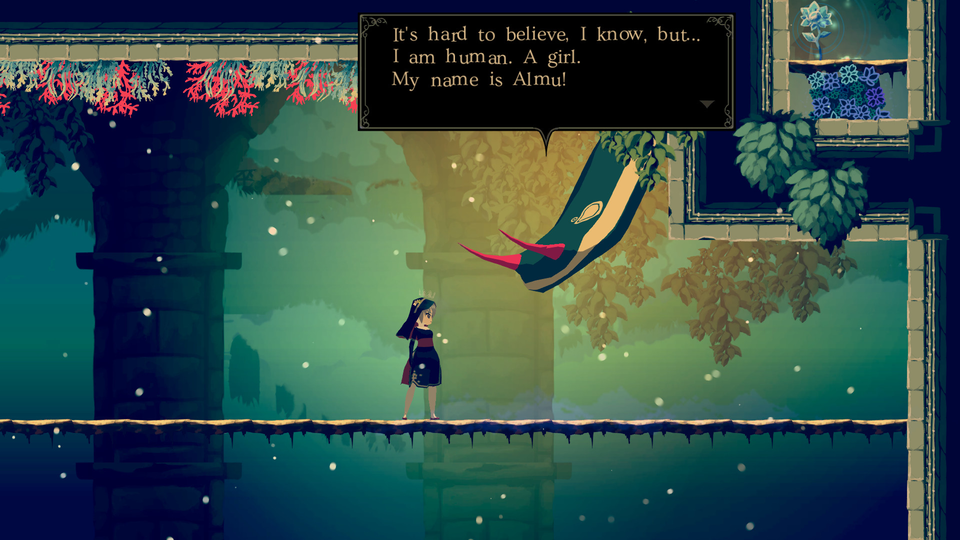
Another way of going about this is letting the player choose whether to spare bosses or finish them off once they reach their weakened state, and the ending you get is dictated by whether you spared bosses, slew them, or were wishy-washy. An even more brazen move would be to wipe away the story altogether and have only the lore to carry the narrative à la Dark Souls. That's partially why Momodora IV's narrative works as well as it does: the story's barely there, so much of the experience is shouldered by the atmosphere and NPC side stories. Minoria has some strong bones in its lore, but its story is atrophied muscle barely keeping the bones from falling and shattering.
Combat
Some years ago, I played Tales of Arise, and while I have numerous hangups about the combat, the one pertinent to this discussion is its dodge. Arise grants you the ability to dolphin dive out the way of incoming enemy projectiles or headbutts, but you're not allowed to dodge if you're mid-animation, i.e., in the middle of an attack, and since plenty of attacks can last upwards of a full second, an eternity when enemy telegraphs are often shorter, it made the dodge functionally less useful, and using it more often than not was a premeditated decision rather than a split-second reaction. “If only I could cancel out of an attack,” I lamented, and Minoria provides the solution I had been after.
Semilla can't animation-cancel, but she doesn't need to, because every action in her moveset is quick and snappy, the anticipation alone measurable by individual frames rather than seconds, and the millisecond an action is finished, the player can input a follow-up command, whether that's a second attack, jumping, healing, or, yes, dodging. It crafts this combat flow not unlike Hyper Light Drifter in which you can roll in on an enemy, slice and dice 'em, and roll out before they counter.
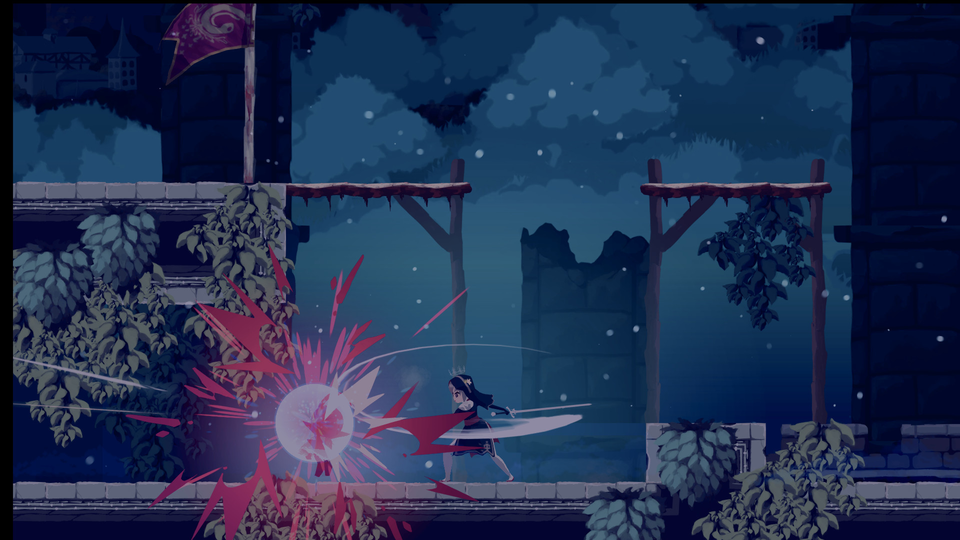
Swiftness isn't Semilla's only weapon, as she comes with a small arsenal, including magic spells, a special heavy attack, and a parry. Talking about these in reverse order—with a few detours—the parry works as anyone who's played a Soulslike would expect: an enemy attacks, you parry, and if your timing's right, you avoid or reduce damage and counter/have the chance to counter. But while the timing of a parry in Dark Souls requires a great deal of practice to get down pat, the window for a parry in Minoria is open quite generously, upwards of a full second, and if anything, and I do mean anything, enters that parry radius, Semilla will perform a Persona 5 All-Out Attack on everything on screen, even some bloke who's just spectating. At the cost of the satisfaction of pulling off a trick move, Semilla's parry comes with an easy-to-read display of when it'll counter, and since it can also be triggered midair, it's a tremendously useful tool in Semilla's toolbox. My only complaint is that it doesn't perform the All-Out Attack on bosses, merely deflecting oncoming damage, and the supplementary damage would be a godsend, because the bosses all are damage sponges.
Semilla also has a special heavy attack that has limited charges and deals whopper damage, and the exact heavy attack is determined by Semilla's sword, which is cool, and would be cooler if this game had more than two swords.
Even though a weapons list for this game will display more than two swords, there's only two types of swords: swords that provide extra lift when swung midair and swords that don't. There's also a ladle that serves as a gag weapon that does such pitiful damage, Semilla could inflict more pain by using her thicc figure to hip-check all the baddies. All the non-gag weapons have the same 1.0 multiplier, and this combined with the differences in utility and heavy attacks could on paper grant the player freedom to customize their fighting style. Maybe Semilla can thrust in any direction with a rapier or a hand-and-a-half knocks baddies back farther, or she uses a shortsword to spin around, slashing baddies on both flanks. There are so many possibilities for how Semilla's arm can alter her fighting style and even maneuverability that it's baffling as to why the game stops at two types of swords, one of which I never used because the extra lift in platforming was too good to give up.
On the topic of platforming, just like Momodora: Moonlit Farewell after it, Minoria commits the sin of having a fantastic array of maneuvers and never the opportunity to fully utilize them. I've already mentioned the extra sword lift, which I used to access areas early once or twice, and then there's also this game's version of the double-jump, a wide slash that both doubles Semilla's altitude and cuts any baddie unlucky enough to be on the platform above. I can't express how much I love that this game looked at the standard double-jump, said that was too boring, and instead imports Alphen's Lightning Thrust sans lightning to kill two birds with one sword. And yet, that's not even the coolest attack in the game. In the final two or so hours, Semilla gains a forward-dash, but even a standard forward-dash is too banal for Semilla, who performs Byakuya's Flash Blossom, zipping past and cutting down baddies. They don't even need to be in her path. Standing below her flight lane is enough to receive lacerations.
While these moves are all great and flashy in combat, like I prefaced in the last paragraph, these maneuvers aren't used beyond their standard function. When you arrive at a platform twice as high as usual, you use your Lightning Thrust sans lightning to reach it. Huge gap in the room? Flash Blossom over it. And just as I said in regards to Momodora V, Minoria doesn't chain these moves or push their uses to their limits. At no point is the player required to gain altitude via Lightning Thrust sans lightning and then dart to a far platform with Flash Blossom, nor do they twirl their sword midair to get just the right altitude so that they can Flash Blossom through a crevice. All the platforming is safe and vanilla, and having all these awesome moves you can't do much with is like getting a sword that instantly sets enemies ablaze, but the only enemies present are Slimes.
Continuing with this tone of lackluster utilization, the final combat weapons are magic spells, which come in two flavors, active and passive. Off the top of my head, the only passive spell I remember is the one that chimes when you're near a secret, and I had to boot up my save file to refresh my memory on what was on offer, and seeing that selection explained my lapse in memory: the passive spells aren't that remarkable. Effects are incremental, such as extending enemy stuns, or come in twos, like one spell that doubles experience and another that nullifies it. These spells aren't useless, but they do fade into the background when the flashy swordplay takes center stage, and if they were removed from the game entirely, aside from the spell that directs me to secrets, I probably would've had next to no change in my combat experience.
Active spells do stand out more, but not by much. Their basic functions, when you break them down into numbers, is “do moderate damage with less accuracy or delayed results.” A laser beam spell is fast, accurate, and strong, but use is discouraged by the next issue, limited charges. Minoria runs into the same problem as Super Castlevania IV. The first Castlevania has subweapons like knives, crosses, and axes to supplement the limitations of the whip. Super Castlevania IV unfastens many of these limitations but keeps in the subweapons due to series tradition, and it pulls out questions from players like, “Why would I throw a slower axe with finite uses when I can just quickly whip diagonally as many times as I want?” Minoria begs the same questions: “Why would I spend a spell charge to summon a giant dragon head that crunches down after a second when I can get three sword swings in that time at no cost?” None of Minoria's active spells cover weaknesses of the swift, versatile combat, and the only compliment is the spell that boosts attack for HP.
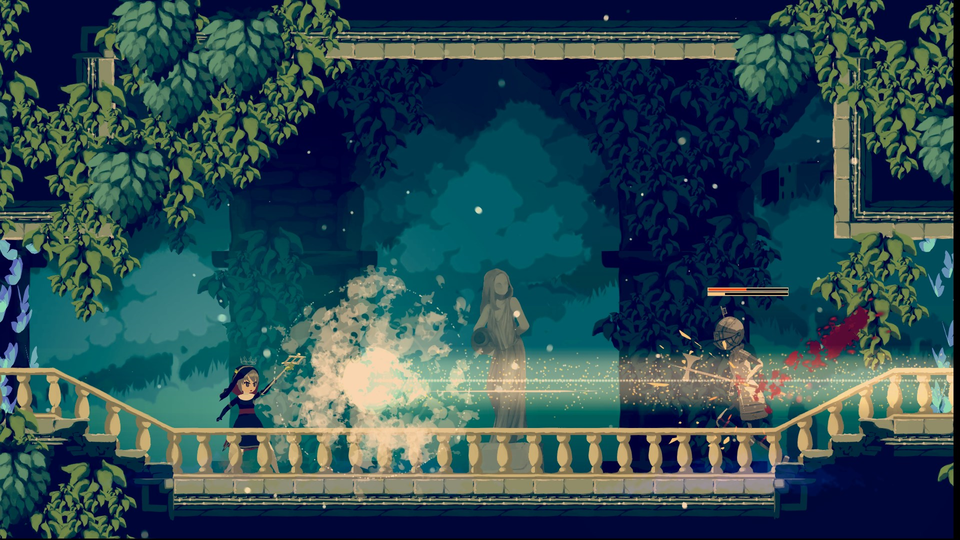
On top of being inferior to basic swordplay, active spells come with an additional issue. In pretty much every Soulslike, healing is a designated button accessible 24/7. Minoria, however, puts healing on the same conveyor as an extra pair of active spells you need to rotate through to access. A number of my deaths came from hitting the heal button only to call forth a hail of swords on a random floor tile because I had forgotten I had switched to that in the heat of battle. This, in combination with their limited uses, is why my only use for active spells was to blitz them on bosses at the very start of a fight before switching back to my healing.
Even if you cut away the spells wholesale, leaving the leanness of the combat, great as it is, it, just like the platforming, runs into the same issue in that nothing's a true challenge and test of your skills. For the platforming, I used a combat scenario as a metaphor for comparison, but this time, there's no need for a metaphor, because that's exactly how it is. Minoria's baddies are pretty standard. They have one, maybe two, attacks and heavily telegraph them, and only one or two baddie types are any real threat. Everything else, Semilla can just walk up, slice 'n' dice 'em, then be on her way, or even stand there and parry their attack. It's the exact same mistake Momodora V would go on to make in how, by the end of the game, the protagonist has a versatile and fluid moveset and precisely one boss that forces you to go all out. Compare and contrast this with something like Touhou: Luna Nights, whose central mechanic is time manipulation. Slowing down or stopping time isn't an option to defeating baddies, but a requirement. Some baddies are simply too fast or won't hold still, forcing you to shrink the time scale to get your hits in. This extends to the environment as well, with chandeliers that'll suddenly drop on you or water you can walk on so long as time isn't moving.
Imagine if Minoria adopted this philosophy. Say there's an enemy only vulnerable from the backside, but simply rolling behind them isn't enough, so you have to stun them with a Flash Blossom before carving Semilla's initials on their bahookie. Or a flying enemy that'll back off once it takes a hit or two, so you catch up using a Lightning Thrust sans lightning. Heck, you might not even need fancy gimmicks. Dark Souls 1 & 2 each have slow, deliberate combat, and 3 dials up the speed, and enemies in turn are just as swift. If Minoria's current roster of baddies were all quicker in their attacks, they might have given me a legitimate run for my money instead of feeling like amateurs I was clowning on.
The Sexy
Something I didn't bother to bring up in my Momodora V review is that Bombservice games tend to feature random flashes of fan service for no reason other than just because. A recurring boss in Momodora IV is a giant lady with massive knockers, and Momodora V doubles the ante with two giant ladies with massive knockers. Minoria, despite being the darkest, most morbid and goriest title in the developer's catalog, contains the most titillation. The princess wears a low-cut gown and has breasts that obey their own laws of physics, Semilla fights a band of thieves who house themselves in an underground dungeon, which I think would be chilly but apparently is steamy since they're all dressed for the Swimsuit Issue of Sports Illustrated, and the third-to-last boss is a giant lady with massive knockers known as the Witch of Lust. I have to ask: Why the Witch of Lust? I would think a Witch of Lust would be more effective against a male protagonist, unless the plot twist is that Semilla is a lesbian and what I was playing was a yuri all along.
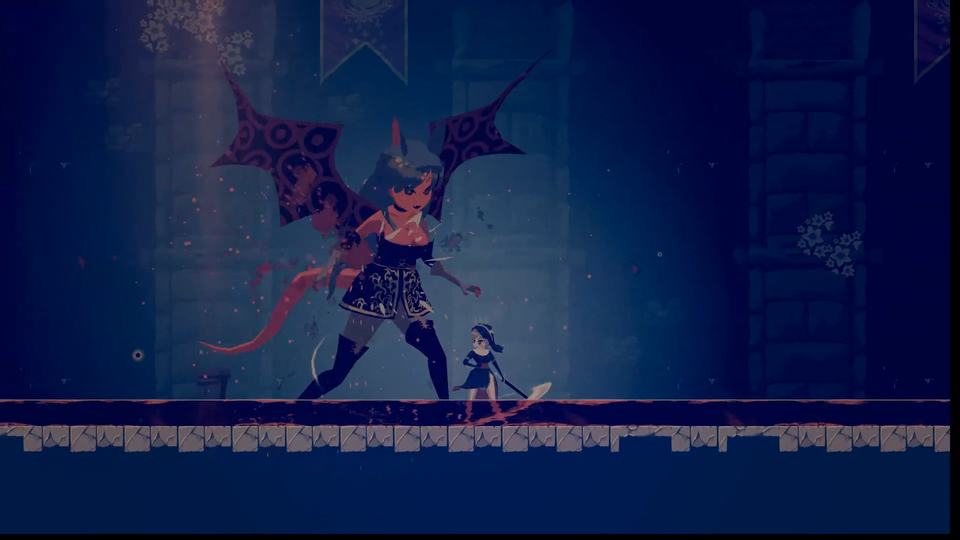
Castlevania: Portrait of Ruin handles seduction better with its boss Astarte, who will charm the male protagonist Johnathon to fight on her side, but her spell's ineffective on the female protagonist, Charlotte. It's a right pain to deal with, but it leans into sexual content better than Minoria, which only puts mammary glands on the screen for players to behold like it's an art exhibit dedicated to the booba. Although I'm a heterosexual male who quite fancies the female figure, I'm not sure how games and anime are expecting me to react when I'm enjoying a distinctly not-hentai and a woman steps into the scene and her breasts go boing-oing-oing-oing-oing. Whilst traversing the dank, dangerous remnants of a cathedral-turned-war zone, and I'm only speaking for myself here, the thought at the forefront of my mind isn't, “Boy, I sure do wish I had a pair of boobies I could motorboat my schnozzle in.”
Dark Souls, possibly the most respected video game in the last fifteen-odd years, does technically feature an instance of gratuitous fan service in Gwynevere, a giant lady with massive knockers, but there's a story behind that design, which is, put succinctly, the concept artist was so proud of their design, Hidetaki Miyazaki didn't have the heart to shoot the concept down. Maybe there's a situation like that on the Bombservice team. I don't know. But supposing this is the case and the Witch of Lust had to stay, the game could've leaned into her concept more. Rather than just being a giant lady with massive knockers, she could also command an army of men she's charmed and seduced, and it would go a ways to explaining the lack of male NPCs.
Conclusion
Minoria is a great game, with fast-paced, versatile combat and dark, engaging lore, and would be a fantastic game if it had the level design, enemy variety, and story to complement these great aspects. But what's great is so great that I could overlook the shortcomings while playing. Minoria was quite the enjoyable experience, with it claiming the spot as my second-favorite title in Bombservice's catalog, just after Momodora : Reverie Under the Moonlight, and had it nailed all its landings, it would be a worthy challenger for that top spot.
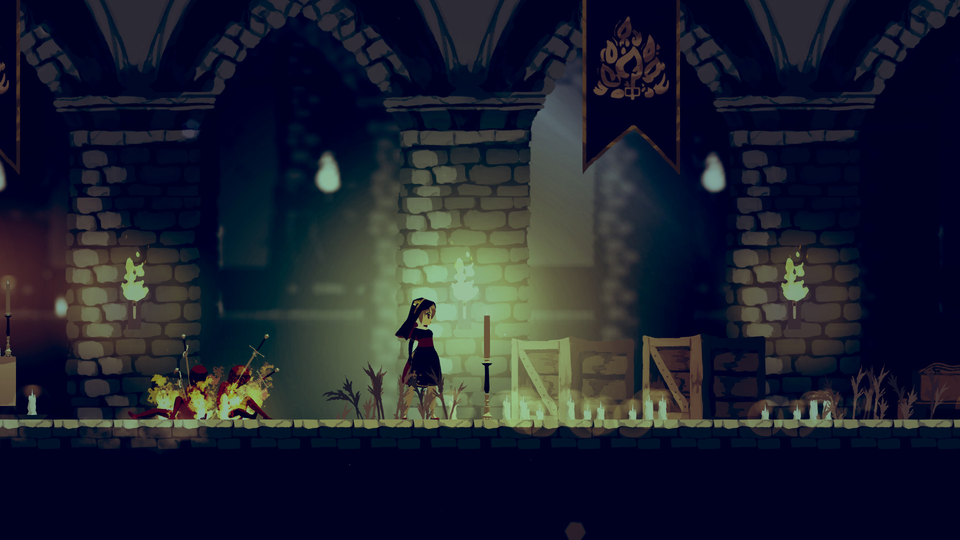

Just writing about the video games that tickle my fancy when the fancy strikes.
posted by Ross Locksley on 30 Oct 2025
posted by Eoghan O'Connell on 30 Oct 2025
posted by Majkol Robuschi on 30 Oct 2025
posted by Ross Locksley on 28 Oct 2025
posted by Ross Locksley on 28 Oct 2025
posted by Ross Locksley on 23 Oct 2025
posted by Dan Barnett on 20 Oct 2025
posted by Robert Mullarkey on 14 Oct 2025